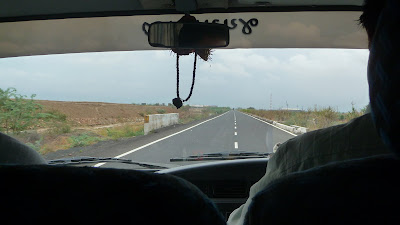It's interesting for me to see such different types and locations of worship, each with its own approaches.
First, we visited the ruins of a mosque located in an old fortress.
Next, we visited various Hindu temples all over Saurashtra, including the locations where the Lord Krishna is supposed to have "died" (let go of his human form).
Shrine by a temple
In the Hindu Somnath temple, located on a beach, as everyone was clapping and shaking their heads with smiles on their faces, pressing together to get as close to the relics as possible, raising their arms while chanting prayers in different speeds and tones, ringing the big bell, and drums were playing and someone was blowing on a conch shell, I felt a real sense of uplifting and camaraderie. I saw a moment in which everyone was really worshipping together.
At the beautiful Jain Derasars, I found similarities with other Hindu temples in the barefootedness and mutliple shrines erected around the derasars--shrines found on trees or at the side of the steps leading to a temple are not uncommon in India. I also found a different approach to worship. I saw white-haired people climbing 3500 steps barefoot, alongside herds of cows, donkeys, and dogs to get to some 50 to 100 Derasars (temples) at the top of the mountain in Palitana. I also saw women with heavy loads on their heads, herders, and little children climbing to the top. Very religious Jains climb the mountain to worship at the Derasars 90 times in 4 months as a sort of penance, to show the lengths they are willing to put themselves through to get closer to god and worship him in the fullest way possible.
The beginning of the climb
One of the early Derasars
Some little temples that serve as rest stops on the way up
A shrine by the side of the steps
Women coming back down from the Derasars
Gorgeous Derasars at the top:
In a completely different way, observing those quietly worshipping in a church or singing a hymnal gives me a sense of spirituality as well. It's interesting that tranquility and loud chanting, sitting in an air conditioned place of worship and braving the monsoon season or the hot summer to climb thousands of steps, though very different approaches, are all ways that people try to get closer to god.
For me, seeing these beautiful types of worship makes the unavoidable and all too prevalent contrasts of religious violence and the isolation of religions hard realities to accept in today's world.






















































